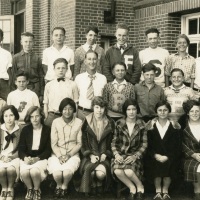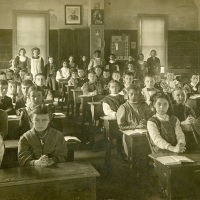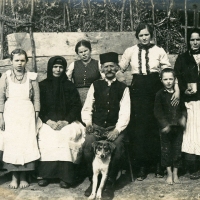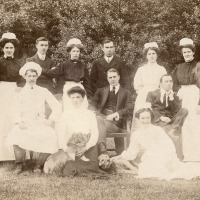On November 11, 1918, an armistice came into effect which ended the fighting on the Western Front in the First World War. In connection with that event, many countries observe a public holiday or official day of remembrance on November 11 each year. In the United States, Veterans Day honors all veterans of the armed forces. (Those who died while serving in the armed forces are honored separately on Memorial Day.) Commonwealth countries observe Remembrance Day, while France and Belgium observe Armistice Day (Armistice de la Première Guerre Mondiale). Germany observes Volkstrauertag (people’s day of mourning) on the second Sunday before Advent (Nov. 17 this year) to commemorate the people of all nations who have been killed in armed conflicts.
I have many photos that were taken during the years of the First World War. Some show soldiers near the front lines. A few show wounded soldiers with medical staff. A few show politicians with stern expressions, while others show ordinary people doing things that have little or no connection to the war. I wanted to feature one photo in this blog post, but which one? Could a single image evoke a long and devastating conflict? Possibly, but that’s asking a lot. I settled on the postcard above, sent by a German soldier in 1917. The wooden sign at upper right says Wald-Kirche (forest church). I find the absence of people in the photo haunting, as though the church had been built for congregations of men who served their countries and never returned.
The Star of David reminds us that Jews also served and died for their homeland.


Update (Nov. 9): In a comment below this post, Joachim at Bibliothekspostkarten very kindly transcribed and translated the message above:
Im Felde, 11.7.
Lieber Vater!
Zum 17.7: Herzliche Glückwünsche zum Namenstage sendet Dein […] Sohn Fritz.
In the field, 11.7.
Dear father!
Congratulations on your Name day on 17.7. from your […] son Fritz.
Joachim did the same for the address area of the card:
Feldpost / Herrn / Heinr. Menke / Landwirt / Davensberg / bei Münster / Westfalen
Military Mail / To Mr. / Heinrich Menke / farmer / Davensberg / near Münster / Westphalia

You can see a larger scan of the back here.
To all my readers and blog friends, Peace.
Brad Purinton










A very haunting photo. It does seem like it was built for those lost in the war. Or a silent reminder of what will happen if people do not learn to live in peace.
LikeLiked by 2 people
I’m sure this place heard many prayers for peace. It may have brought the men some comfort.
LikeLiked by 2 people
For me, that’s a very disturbing image.
LikeLike
Jews served in all the combatant armies. I think–I hope–this image honors that service.
LikeLiked by 1 person
I hope it does.
LikeLiked by 1 person
Thank you, Brad. This photo is very moving.
LikeLiked by 1 person
Thank you, Carol.
LikeLike
I agree, the absence of people is very haunting. And it’s a postcard! It would be great to know what it says.
LikeLiked by 1 person
Thank you, Robyn. The soldier would have had other postcards to choose from, so he chose this one for a reason. I think the message is about something else, though.
LikeLiked by 1 person
Brad it is a terrible writing in “altdeutsch” (Old German). I can´t read all. Just this:
Im Felde 11.7.
Lieber Vater!
Zum 17.7: Herzlichen
Glückwunsch zum
???tag
funkt Dein ???
Sohn Erik
In the field (battlefield) 17.7.
Dear father!
To the 17.7: Congratulations to
???day
sparks your ???
son Erik
I´m sorry that I can´t read all. Hope it was helpful.
LikeLiked by 3 people
Thank you, Kristallina! You got more of it than I did. The writer’s name looked like Fritz to me, but I wasn’t sure.
LikeLiked by 1 person
Kristallina, I’ve just updated the post with a translation provided by another blogger. Thank you again! Brad
LikeLiked by 1 person
I saw it. It´s probably Fritz but it is definitely not “sendet” but “funkt” (spark). i think he is kidding a little bit. Really nice that you got two followers who tried to help. Have a nice sunday!
LikeLiked by 1 person
Wow… what a photo.
LikeLiked by 2 people
Thank you, M.B.
LikeLiked by 1 person
The image left a sense of emptiness and abandonment, or as you put it, haunting. The photo reveals a part or a moment of WW1 and opens to multiple interpretations. I watched the film They Shall Not Grow Old a few months ago, and it was heartbreaking to be reminded of the brutality of WW1. Thanks for sharing it with us, Brad. Peace and love.
LikeLiked by 3 people
Thank you so much, Isabelle. I haven’t watched the Peter Jackson film yet. WWI should have been the war to end all wars.
LikeLiked by 1 person
Well said, Isabelle.
LikeLiked by 2 people
Thank you.
LikeLike
I think you made a an excellent selection. An empty church in the woods evokes the hell of war.
LikeLiked by 2 people
Thank you, Eilene.
LikeLiked by 1 person
Brad, this was a beautiful share, so full with the emptiness that wars bring. A small silent place in the trees, thank you and great peace to you as well. 🌷
LikeLiked by 2 people
Thank you for your kind words, Suzanne.
LikeLiked by 1 person
The already poignant photo is made even more so by the haunting combination of the Christian cross and the Jewish Star of David at the altar. The star certainly has been used in churches for centuries. Still, given the number of German Jews who died in WWI and the history of WWII still to come, the emptiness here seems like a pivot point between a terrible past and an even more terrible future.
LikeLiked by 2 people
I agree, Linda. I wanted to focus on the tragic context of WWI, but our knowledge of what was to come makes this image incredibly poignant.
LikeLike
The juxtaposition of the cross and the Star of David struck me immediately as well.
LikeLiked by 1 person
Hello, thanks for posting this interesting photograph! Here is what I can make of the writing: Adress: Feldpost / Herrn / Heinr. Menke / Landwirt / Davensberg / bei Münster / Westfalen (Translation: Military Mail / To Mr. / Heinrich Menke / farmer / Davensberg / near Münster / Westphalia ). Message: Im Felde, 11.7. Lieber Vater! Zum 17.7. Herzliche Glückwünsche zum Namenstage sendet Dein … Sohn Fritz. (Translation: In the field, 11.7. Dear father! Congratulations to your Name day on the 17.7. sends your … son Fritz). „Im Felde“ means, that the writer was at war when he wrote the postcard.
LikeLiked by 3 people
Thank you so much, Joachim! I’ll update the post today. I looked on Ancestry for a Heinrich or Fritz Menke in Davensberg, but didn’t find them. I was hoping to learn whether Fritz survived the war. It was thoughtful of him to send his father a card from the field. The message doesn’t provide us with any clues about why he chose this card. I wondered if his father might be a minister, but apparently he was a farmer.
LikeLiked by 1 person
Joachim, I’ve just updated the post. Thank you again!
LikeLike
So great you had help making out what the card was all about! Just thinking about how this man takes the time and effort to send a greeting for his fathers namesday, during a gruesome war. Perhaps thinking about your close ones, remembering their important days, is a way of surviving as well – at least mentally.
LikeLiked by 3 people
Yes, thinking about loved ones might be a way to avoid unpleasant thoughts or circumstances. It also occurred to me that soldiers might have a lot of time with nothing to do, so writing letters might be an escape from the monotony of waiting for something to happen (something which might be bad).
In the text of the post, I didn’t mention that I hesitated to share this image for a long time. I felt that it was a very powerful image, but also that the context for sharing it mattered. It wasn’t something to share casually. That’s why the text of the post was mostly about the context, rather than the subject of the image itself. I felt a lot of anxiety after publishing it, and slept poorly that night as a result. Fortunately it was received with understanding by readers. It was definitely the most stressful post I’ve ever done.
LikeLiked by 1 person
Your post was most respectful and well balanced, I find. It’s certainly important to remember the horrors of war and those, who gave their lives. What were your expectations when sharing the post?
LikeLiked by 1 person
I don’t think I had any expectations, per se, but I knew that the religious symbolism could be potent and upsetting. Readers probably wondered why I didn’t talk about it, but I felt that they would respond to it in their own way, i.e., that I shouldn’t tell anyone how to feel about it. I think my anxiety also stemmed from a concern that by not talking about it, I might give the impression of being indifferent to it, but the truth was just the opposite.
LikeLike
It’s a beautiful picture. I think the picture was deliberately taken of the empty church, it is more a memento of the place than of the activity of conducting a service, and it makes for a particularly contemplative picture. I was wondering about the little sign below ‘Wald-Kirche’, but then I noticed that the number is the same as in the stamp on the postcard – Res(erve) Inf(anterie) R(egiment) 255, so it’s presumably the army unit in which Fritz served. I was also wondering where the picture was taken. Lots of birch trees etc, reminded me of fairly northern landscapes, Finland or Russia.
I saw this on Friday but didn’t have the time to react. I was going to come back and do a proper transcription of the text, but happily someone else had already done it. Interestingly, when you look up when Heinrich has his Namenstag, a number of options come up, but 17.7. isn’t one of them!
LikeLiked by 2 people
You have a very good eye! I should have mentioned Fritz’s regiment in the post. When I was researching the photo a year ago and trying to find another example of it–which I never did–I ran across one reference to Reserve Infanterie Regiment 255. In October 1917 it took part in Operation Albion, which was a successful invasion of the West Estonian archipelago. (The regiment is mentioned here: http://www.avalanchepress.com/Operation_Albion.php). So your theory is most likely correct, that the regiment was stationed in the north near the Baltic Sea. Operation Albion created a great military advantage for Germany by bringing its forces much closer to Petrograd. The operation took place October 12-20, 1917. The Bolshevik Revolution occurred less than three weeks later, on Nov. 7. With the Soviets suing for peace, the military advantage created by Operation Albion no longer mattered and it became little more than a historical footnote.
I wonder if Heinrich’s Namenstag was based on his first name or his middle name? We don’t have name days generally in America, so it’s not a tradition I’m familiar with. Thank you for all your thoughtful comments and observations!
LikeLiked by 1 person
A beautiful location for a church, but the photo does feel very haunting without people. I hope those who visited this church found solace and comfort from the effects of that ghastly war.
LikeLiked by 2 people
I hope so, too. Thank you for your comment, Ruth.
LikeLiked by 1 person